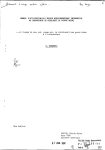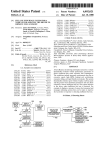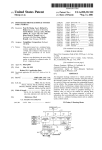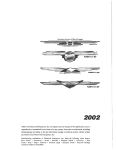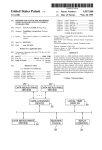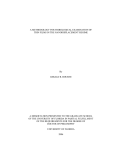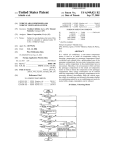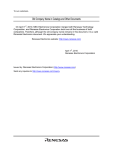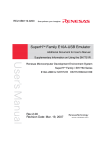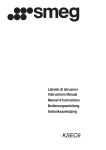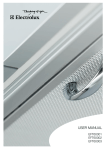Download HvAc CO2 /-16
Transcript
US005775406A United States Patent [191 [11] Patent Number: 5,775,406 Ghitea, Jr. [45] Date of Patent: Jul. 7, 1998 [54] VENTILATION MESSAGE DISPLAY SYSTEM AND METHOD FOR A VEHICLE _ . . Caterpillar. Feb. 1995. Inventor‘ Nicol“ Ghltea’ Jr" Tlgard' 0mg‘ . _ . . ProDriverTM User Manual, Detroit Diesel Corporation. . Man. Asslgnce' gelghthner corporation‘ Portland“ eg' CELECT RoadRelayTM User’s Guide, Cummins Cadee. 1993' 6 . ' Primary Examiner—W11liam E. Wayner [51] Int. Cl. ............................. .. G05D 23/00; F24F 7/06 [52] US. Cl. ......................... .. l65/1l.1: 165/248; 236/94; 454/229 Field of Search 1994. Model ZOOSAD High Level Pre-Amp OEM Carbon Dioxide Monitor; v11 Valtronics. Revised Jun. 20. 1996. pp. 1-3; Revised Jun. 11. 1996. pp. 4-6. & 8. [21] APPL No‘: 674,134 Jul. 1, 1996 [22] Filed: [53] OTHER PUBLICATIONS Owner’s Manual Caterpillar Driver Information Display, Attorney, Agent, or Firm—Klarquist Sparlcman Campbell Leigh & Whinston LLP [57] .................................. .. 165/11.1. 249. 165/248; 236/94_ 493; 454/229_ 75_ 257 ABSTRACT _ _ _ l _ _ A ventilation d1splay system determines when a vent1lat1on system has remained in recirculation mode for a prede?ned _ References Clted [56] time. and in response generates a stale air alert message inside the cab of a truck. The system can generate messages US Pm DOCUMENTS 3,418.9!4 12/1968 Finkin ..................................... .. 454/75 alerting the driver that the HVAC system has switched into recirculation mode. and alerting the driver that the recircu~ l?tio" H1096 has IFm?iWd activ? for the Pfcd??lJed time 4,25s,421 5,303.163 When e*qmpped Wlth ‘1 C02 SEIISOL the System can generate air quality messages based on either the status of the 3/1981 Juhasz et a1. .. 364/424 4/1994 Ebaugh et a1. ........................ .. 364/550 recirculation mode or the level of CO2 in the cab of the truck or both. FOREIGN PATENT DOCUMENTS 40424541 9/1992 Japan ................................... .. 454/229 HvAc 14/ SENSOR , 'NpluT _ 12 Claims, 2 Drawing Sheets CO2 /-16 SENSOR r18 CONTROL 12\ DISPLAY DEVICE = 10 4 TIMER US. Patent Jul. 7, 1998 Sheet 1 of 2 HVAC F|G_ 1 002 14/ SENSOR I 'NPUT ' \ 16 SENSOR/ I CONTROL DEVICE 5,775,406 ‘ 18 Tqh-AER ' UNIT 12\ DISPLAY 10 DEVICE FIG. 2 46.1 12 22 2s HVAC 602 66/ SENSOR ‘ FIG 3 Y = SENSOR \68 M74 ND CONVERTERS \70 ' 44—\ DISPLAY DEVICE A ROM -J \ 52 ¥ (~50 I k I 58 EEPROM‘J ‘D 12“ KEYPAD MEMORY 6Q 72 I V l PORT “ INTERFACE 54 II I 3 56f I BUZZER /8° 5.775.406 l 2 VENTILATION MESSAGE DISPLAY SYSTEM AND METHOD FOR A VEHICLE FIG. 6 is a diagram illustrating an implementation of a message display to alert the driver that the HVAC system has been in recirculation mode for a prede?ned time period. TECHNICAL FIELD DETAILED DESCRIPTION The invention relates to a message display system for vehicles and more speci?cally relates to a message system for generating messages regarding the air quality in a vehicle. BACKGROUND OF THE INVENTION 10 The heating. ventilation. and air conditioning (HVAC) systems in many of today’s cars and trucks commonly have The message system can also include a C02 sensor 16 to a recirculation mode where air is recirculated within the vehicle. When switched into this mode. the HVAC system detect when the CO2 level in the vehicle reaches a pre de?ned level. When equipped with a C02 sensor. the mes sage system monitors the level of CO2 in the vehicle. and in recirculates the air in the vehicle rather than drawing “fresh” air into it. If left on too long. carbon dioxide can build up addition. keeps track of how long the HVAC system is in the inside the vehicle and degrade the air quality. As stale air builds up. the driver can become drowsy due to the lack of fresh air. Despite the potential hazard that a build up of CO2 in the vehicle creates. the inventor knows of no vehicles that have a message system to warn the driver of this hazard. There is a need. therefore. for a warning system to alert the driver when he or she has left the HVAC system in recirculation mode too long. recirculation mode. The system can generate a warning message alerting the driver that the air is stale based either on the CO2 level in the vehicle. or the length of time that the HVAC system remains in recirculation mode or both. The control unit in FIG. 1 monitors the state of the recirculation mode through the HVAC sensor 16. The HVAC 25 SUMMARY OF THE INVENTION The invention provides a message display system and related methods for displaying stale air alert messages in response to detecting poor air quality conditions in a vehicle. sensor is a control circuit used to monitor the switch activity of a recirculation mode control in the HVAC system. For example in one implementation. it is a control circuit coupled to a recirculation switch in the HVAC system. and it generates a signal indicating that the HVAC system is in 30 recirculation mode. The control unit monitors the state of the recirculation mode by monitoring the signal from the HVAC sensor and keeps track of elapsed time when the recircula The message display system monitors the control circuitry of the ventilation system to determine when it has switched to recirculation mode. The system tracks the elapsed time while the ventilation system is in recirculation mode and generates a warning message if the ventilation system FIG. 1 is a functional block diagram illustrating one implementation of a ventilation message system in a vehicle. In this implementation. a control unit 10 monitors the HVAC system through an HVAC sensor 14 and generates the display of a warning message or messages on a display device 12 when it detects that the HVAC system has remained in recirculation mode for a predetermined time. tion mode is active. The message system can optionally include a timer 18 to 35 keep track of elapsed time when the HVAC is in recircula tion mode. The timer is not necessary. of course. if the control unit is implemented using a processor that provides timer services. The CO2 sensor shown in FIG. 1 detemtines the CO2 level in the vehicle and generates a signal representing the CO2 level or representing that the CO2 level has exceeded a threshold. In the ?rst case. the control unit computes when the CO2 level has exceeded a prede?ned threshold. while in the second case. the control unit detects that the CO2 has exceeded a threshold from the signal generated by the remains in recirculation mode for a predetermined time. The system can optionally include a C02 sensor to monitor CO2 levels in the vehicle. When equipped with the CO2 sensor. the system can generate air quality messages when either: 1) the system determines that the CO2 level exceeds a prede?ned threshold. or 2) the system determines that the recirculation mode has remained active for a pre de?ned time period. The system can monitor both conditions and display an alert message. so long as either of the 45 sensor. conditions are satis?ed Alternatively. the system can moni The message system can optionally include an input tor the recirculation mode as a supplement to monitoring device 20 to enable the user to enter input commands to the CO2 level in the vehicle when it detects that the CO2 sensor control unit and control its display. Preferably located at the is not operating properly. dash of the truck. the input device 20 enables the driver to 50 Further features and advantages of the invention will supply inputs to the control unit and control the display. For become apparent with reference to the following detailed description and accompanying drawings. example. the driver can use the input device to clear the ' message display. or the driver or other operator can use the input device to con?gure the control unit to control how it BRIEF DESCRIPTION OF THE DRAWINGS FIG. 1 is a functional block diagram illustrating one implementation of a ventilation message display system. FIG. 2 is a perspective view illustrating the layout of instruments and controls on a dash incorporating one embodiment of the invention. 55 displays messages. While the control unit can be located in a variety of places in the truck. it is preferably located in the dash. The display and input devices coupled to the control unit are also preferably located at the dash so that the driver may easily view the display and access the input device. FIG. 2 is a diagram illustrating the position of one form of a display 12 and an input device 20 among the instru FIG. 3 is a block diagram illustrating the instrumentation control unit (ICU) in an embodiment of the invention. FIG. 4 is a diag'am of one implementation of an input device of the ICU shown in FIG. 2. FIG. 5 is a diagram illustrating an implementation of a ventilation message system for a truck. The dash 22 shown in FIG. 2 includes a number of gauges. including for message display indicating that the HVAC system has been placed in recirculation mode. fuel gauge 28. etc. Instruments located at the dash may ments and controls on a dash 22 in one implementation of example. an analog speedometer 24 and tachometer 26. a 5.775.406 3 4 include a parking brake switch 30. air suspension switch 32. HVAC controls 34-40. etc. The HVAC controls include a recirculation mode switch interface 54. The port interface. in this implementation. is an interface to a data link comprised of a twisted pair cable. This particular data link is designed according to SAE 34. fan speed control 36. HVAC master switch 38. and air temperature control 40. The recirculation mode switch 34 microcomputer systems in heavy duty vehicle applications. J 1708. a standard for serial data communication between enables a user to select a recirculation mode in which air is Electronic devices connected on the data link. such as the recirculated in the vehicle. by a fan (not shown) and a fresh air mode in which fresh air is drawn from outside the vehicle. The fan speed control is a conventional control used to control the fans in the HVAC system. The HVAC master ICU 48. communicate with each other according to proto cols de?ned in SAE J 1708 and SAE J 1587. The SAE 11587 switch is a conventional control enabling one to select an Vehicle Applications.” This standard de?nes the format of data and messages communicated among microprocessors connected to a shared data link. and is speci?cally adapted standard is entitled “Joint SAFJTMC Electronic Data Inter change Between Microcomputer Systems and Heavy Duty operating mode for the HVAC system including air conditioning. defrost. vent. etc. The dash also includes the display 12 for a control unit of a message system. The control unit is referred to as the for use with SAE 11708. instrumentation control unit (ICU) in this implementation. A user can con?gure the ICU 48 by setting parameters in a con?guration ?le and downloading the ?le to the ICU via the port interface 54. The con?guration ?le includes a number of parameters that control the operation of the ICU. One type of parameter is a display format parameter used to control the message display. By setting the value of a display The user interface of the instrumentation control unit includes a message display panel 46 and keypad 44. both located on the dash. The keypad 44 is one way to implement the input device 20 shown in FIG. 1. A variety of conven tional input devices can be used in the alternative. 20 The display device 12 presents a two-line display at panel parameter to prede?ned values. the user can select among 46. sometimes referred to as the “message center.” In the prede?ned display formats such as display message once for 7 seconds. or repeat this message every 254 seconds. The con?guration ?le includes additional parameters used to set the conditions that trigger a warning message. For example. implementation shown here. the display panel 46 comprises a two by 20 vacuum ?uorescent (VF) display. The display device can be implemented using other conventional display technology such as a liquid crystal display (LCD). light emitting diode (LED) or other display device. The illustrated the activating time for a “stale air” warning message can be set by setting a value in the con?guration ?le equal to the activating time. in minutes. for example. or it may be ?xed input device 20 in the user interface is a keypad including both dedicated and general purpose function keys. Alterna at predetermined time. such as 20 minutes. The ICU 48 also includes an input device such as the dash tive implementations using conventional input device tech nology are also possible. mounted keypad 44 and a display device 12. A speci?c of the keypad is shown in greater detail in FIG. 4. The display device 12in FIG. 3 corresponds to the display An instrumentation control unit (ICU) in the vehicle controls the display of messages on the display screen of the display panel 46 shown in FIG. 2. It is responsible for monitoring operating conditions in the truck including the 35 status of the recirculation mode of the HVAC system. FIG. 3 is a block diagram illustrating the ICU 48 in one device 46 described above in connection with FIG. 2. It should be noted that for a lower cost implementation. an indicator light with a message indicating that the air in the cabin is stale could also be used. This indicator light would be illuminated in the event that the ICU detected stale air conditions in the cabin. implementation of the invention. The ICU is typically posi tioned in the truck cab for easy access. and preferably at the dash of the truck. The instrumentation control unit 48 includes a CPU 50. memory 52 and a port interface 54 for connecting the unit to a shared communication link 56. The ICU 48 (FIG. 3) is connected to an HVAC sensor 66 through analog to digital converter (AID) 70. In this imple mentation the HVAC sensor 66 is a switch that electrically connects an input of the AID converter with a power supply. The memory 52 includes programmable ROM 45 When a user selects the recirculation mode via the recircu (EEPROM) 58. permanent ROM 60 and volatile RAM 59. The routines for controlling the ICU are stored in ROM 60. while con?gurable data such as a con?guration ?le is stored in the EEPROM 58. The memory 52 also includes a form of temporary memory such as RAM 59 for temporary storage of program instructions and data. In one speci?c implementation. the ICU has two CPUs and its memory includes EEPROM. ROM. and RAM. The CPUs are 68HC11 microprocessors from Motorola Corpo ration. A ?rst CPU controls the operation of the message display system. while a second CPU controls instrumenta tion integrated with the ICU. Since the second CPU is not used for the message display system. it is not necessary to lation switch 34 (shown in FIG. 2). the HVAC sensor 66 55 As shown in FIG. 3. the ICU 48 can be coupled to a C02 sensor 68 to monitor the CO2 level in the cab of the truck. implement the invention. This speci?c ICU has 8 KB of external EEPROM. 128K of ROM and 2K of RAM. The CPUs internal memory comprises 256 Bytes of RAM and 512 bytes of EEPROM. This is only one speci?c implemen tation of the ICU. A variety of conventional processors and memory systems can be used to implement the functionality of the instrumentation control unit. The ICU 48 can communicate with other electronic devices connected to a shared data link 56 through the port (FIG. 3) supplies a signal to the input of the AID converter 70 indicating that the recirculation mode is active. The ICU is programmed to respond to this signal to display a message acknowledging that the HVAC system is in recirculation mode and to generate a warning message when left in this mode too long. In this implementation. the ICU polls the input to check whether the HVAC signal is active. In the alternative. the ICU can be programmed to respond to interrupts raised when the HVAC signal is activated and deactivated. 65 The CO2 sensor operates in response to control signals 72 from the CPU 50 in the ICU 48 and provides output signals 74 from which the level of CO2 can be derived. A CO2 sensor suitable for this application is Model 2005AD High Level Pre-Amp OEM Carbon dioxide Monitor from Val tronics of Valley Springs. Calif. This CD; sensor passes an infrared beam through a gas cell to determine the CO2 concentration in the cell. The CPU provides a logic level high signal to the sensor for a predetermined period (about 5 .775.406 5 6 4. Trip (Miles. hours) (96) 5. Leg (Miles. hours) (98) 500 ms) to turn on an infrared beam. and then provides a logic low signal for the predetermined time to turn off the infrared beam. The output signal is an analog waveform oscillating between a high peak (after the infrared light is on for the predetermined time) to a low peak( after the infrared beam is off for the predetermined time). The difference between the high and low voltages is indicative of the CO2 The dedicated keys are used to request speci?c informa tion such as the current local time (time). the current temperature (temperature). fuel used. average miles per gallon. etc. The trip and leg keys are used to display the miles travelled and elapsed hours for a trip or a leg of a trip. level in the gas cell. where the greatest difference means approximately zero percent CO2 and the smallest difference The keypad also includes the following general purpose means the full scale percent CO2 in the cell. The CPU 50 samples the waveform through the A/D keys: converters 70 at a ?rst interval when the waveform is at or 1. 2. 3. 4. near its high peak and a second interval when the waveform is at or near its low peak and averages the samples to eliminated noise. The difference between the average at the high and low peaks is a measure of how much C02 is in the gas cell. which is located in the cabin. The CO2 sensor should be calibrated for temperature. This sensor provides a temperature signal from which the CPU computes a tem perature compensation factor (e.g. 0.2% per degree C for every degree change from zero calibration). The CPU cali 20 The CPU compares the CO2 level computed using the These keys can be used to scroll through message screens on the display. enter data. clear messages. etc. For example. these keys can be used to enter con?guration data such as a parameter representing the activating time for a stale air time the HVAC can remain in recirculation mode before the message system alerts the driver. When a warning message is displayed. a key or keys may be used to clear a warning 25 message from the display. In one implementation of the message system. the ICU displays a message when the HVAC systems enters recir culation mode. and displays an alert if the HVAC system remains in recirculation mode for a predetermined time. FIGS. 5 and 6 illustrate examples of these messages. warning message. If the CO2 level exceeds the predeter mined threshold. it generates a warning message. The ICU 48 shown in FIG. 3 may also include a buzzer 80 as an auxiliary warning device used to produce an audio alarm to supplement an alert on the display. For example. the buzzer provides an audio alert for warning conditions such as “stale air. stop recirculation.” In this implementation. the buzzer is integrated into the ICU 48. However. a buzzer or other audio warning device can be implemented as a discrete Right Arrow Key (104) Set/Reset Key (106) warning message. The activating time refers to the length of brates the sensor by providing a control signal that adjusts the sensor through control signal path 72. method above with a predetermined threshold value stored in the ICU to determine whether it should generate a Left Arrow Key (100) Down Arrow Key (102) FIG. 5 is a diagram illustrating an example display message 200 to acknowledge that the system has entered 35 device to the ICU as well. recirculation mode. When the ICU receives a signal from the HVAC sensor indicating that the user selected recirculation mode. it enters a display routine to display this message. The message warns the driver that the air will become stale in a speci?ed period of time. such as 20 minutes. for example. In this implementation. the CPU 50 can control the output of the buzzer to produce different types of audio alarms based on the nature of the warning. For example. the ICU The ICU displays this message and then returns to the normal operation screen 202. In this particular implementation. the normal operation screen 202 refers generally to the screen that the ICU was displaying when the shown in FIG. 3 distinguishes higher priority messages from other messages by playing a continuous tone or a continuous ICU replaced it with the alert message. The speci?c infor mation and format of the information displayed varies series of pulses. For lower priority messages. the ICU plays a limited number of pulsed tones. The CPU in the ICU issues depending on the operating state of the vehicle and. more control signals to the buzzer to cause it to play a continuous 45 speci?cally. the inputs to the ICU. When the vehicle is in tone. a continuous series of pulsed tones (a continuous series motion during normal operating conditions. the ICU dis of “beeps”). or a pulsed response (e.g.. a limited number of plays fuel economy data and an odometer reading. During “beeps”). The ICU can be con?gured to play these audio the ignition sequence. the ICU displays diagnostic warnings along with display messages by setting corre information. and when the vehicle is stationary. the user can sponding parameters in its con?guration ?le. The value of scroll through set-up screens and diagnostic information. While the ICU displays these types of display screens in this implementation. other alternative message screens may be the parameter can specify that an audio warning is to be played along with visual message and can also specify the type of audio alarm (e.g.. continuous tone. continuous series of pulses. or limited number of pulsed tones). The particular ICU used in this implementation is manu factured by Joseph Pollak of Boston. Mass. for Freightliner Corporation. The instrumentation control unit is available as displayed. 55 a replacement part from Freightliner Corporation. FIG. 4 is a diagram of one implementation of the keypad used with the ICU. The keypad includes a number of keys to enable the driver to query the ICU for information and to control its operation. The keypad shown in FIG. 4 includes the following dedicated keys: 1. Time (90) 2. Temperature (92) 3. Fuel (Fuel used. Avg. MPG) (94) The ICU can display a message in a variety of di?erent formats. In this implementation for example. the ICU can be con?gured to display a message in any of number of selected formats such as display message one time only for x seconds. display message for x seconds and repeat every y seconds (where x is an integer in a prede?ned range). display the message until any key is pressed. etc. The ICU displays messages based on selected formats. which can be selected by setting display parameters in its con?guration ?le. Each display message can have an asso ciated display parameter or parameters that the ICU uses to 65 control the display of the message. The value of the param eter indicates how the message will be displayed. A value of NULL or zero means that the message is disabled. a value 5 ,775.406 7 8 of 1 means that the message is displayed once for 7 seconds. and a value of 2 means the message is displayed 7 seconds every 254 seconds. If the display parameter has been set to make an accurate reading. or if the output signals are out of range. the ICU can then monitor only the HVAC sensor as any number in the range from 3-253. the message is displayed until a user presses any key on the keypad. After the user presses the key. the message is repeated in the The ICU can use other approaches as well. For example. the ICU can be programmed to display a warning message based on whichever condition (CO2 level exceeded. or activating time in recirculation mode elapsed) occurs ?rst. In this case. the ICU monitors the CO2 sensor and HVAC long as the CO2 sensor is not functioning properly. programmed time (3-253 seconds). and the cycle continues until the condition that caused the message is no longer satis?ed. If the display parameter has been set to 254 sensors through their respective input signals. The ICU displays an alert message when it detects either of the conditions: 1) the CO2 level exceeds a threshold or 2) the HVAC system has remained in recirculation mode for the (always on). then the warning message is displayed as long as the ICU detects the condition that initially caused the display of the warning message. activating time. The ICU may continue to display a warning When the HVAC system enters the recirculation mode. the ICU enters a display routine to track the elapsed time while in recirculation mode. This routine controls the dis play of warning message if the elapsed reaches a prede?ned time called the “activating time.” The activating time. in this example. corresponds to the time specified in the message 200 shown in FIG. 5 (20 minutes. for example). As the ICU accumulates the elapsed time. it also contin message as long as either of these conditions remain active. As an additional warning. the ICU can sound an audio alarm using an audio warning device such as the buzzer shown in FIG. 3 to alert the driver that it is displaying a message. To enable this feature in the ICU. a control 20 the conditions for the message are satis?ed. the ICU sounds an audio warning in addition to displaying the message on ues to monitor the state of the recirculation mode. If the recirculation mode is no longer active. as indicated by the the display device. signal (or lack of signal) from the HVAC sensor. the ICU exits the routine and thus. ceases to accumulate elapsed time. If the elapsed time reaches the activating time for the stale air alert. the ICU displays a warning message such as shown parameter is set in the ICU’s con?guration ?le. When this control parameter is set for a particular display message and The CPU in the ICU can control the audio output of the 25 buzzer to produce di?erent types of audio warnings for ditferent messages. For high priority warning messages such as the stale air warning. for example. the CPU instructs the buzzer to play a more prominent audio warning such as a continuous series of pulses or a continuous pulse tone. For at 210 (FIG. 6) alerting the driver that the air may be getting stale. FIG. 6 illustrates an example of a warning message 210 displayed when recirculation mode remains active for a prede?ned time. As shown. the message alerts the driver to turn off the recirculation mode. The ICU returns to the normal operation screen according to the selected display mode set for the message as described above. If the message 35 is set to repeat or display the warning message persistently. the ICU continues to monitor the status of the recirculation mode and repeats the warning message or displays it per sistently or continuously as long as the HVAC system remains in recirculation mode. lower priority messages such as when the HVAC system enters recirculation mode. the ICU plays a less prominent audio warning such as a limited number of pulsed tones. This feature enables the ICU to distinguish among diiferent warning messages based on their importance. Having described and illustrated the principles of our invention with reference to a preferred embodiment and several variations thereon. it should be apparent that the invention can be modi?ed in arrangement and detail without departing from its principles. Accordingly. we claim all modi?cations as may come within the scope and spirit of the following claims. When the ICU detects that the recirculation mode is no We claim: longer active. it exits the display routine and ceases to repeat 1. In a vehicle having a ventilation system with a recir the warning message. The ICU returns the display to the culation mode. a message system for the vehicle comprising: normal operation screen 212. a display device; The ICU can also trigger warning messages based on 45 an HVAC sensor operable to generate a signal indicating inputs from a C02 sensor. The warning message 210 in FIG. whether the ventilation system is in the recirculation 6 is an example of possible format for a message alert mode; generated in response to an input signal from the CO2 sensor a control unit coupled to the HVAC sensor and the display indicating that the CO2 level in the cab has exceeded a device. the control unit being operable to receive the 50 threshold value. signal from the HVAC sensor. being operable to detect When the ICU is equipped with the CO2 sensor. the ICU when the recirculation mode is active by monitoring the signal. and being operable to detect a ?rst condition in which a prede?ned time period has elapsed while the can use the HVAC sensor as a supplement to evaluating air quality in the cab of the truck through the CO2 sensor (FIG. I and FIG. 3). For instance. the ICU can display a warning message such as the one in FIG. 6 in both of the following 2 cases: 1) when the C02 level exceeds a threshold. as 55 HVAC system has been in the recirculation mode. and in response to detecting that the ?rst condition is detected through the CO2 sensor. and 2) when the ICU satis?ed. being operable to generate the display of an determines that the HVAC has been in recirculation mode for a predetermined period of time. alert message on the display device. 2. The system of claim 1 wherein the control unit is coupled to an audio warning device; and wherein the control unit is operable to instruct the audio warning device to play an alarm in response to detecting that the ?rst condition is satis?ed. 3. The system of claim 1 wherein the control unit is operable to display a message indicating that the recircula tion mode is active in response to detecting that the HVAC system has been switched into recirculation mode. Alternatively. the ICU sensor can use the HVAC sensor as a back up to the CO2 sensor in cases where it determines that the CO2 sensor is malfunctioning. In this alternative approach. the ICU only monitors the HVAC sensor if it determines that the CO2 is not functioning properly. For instance. the ICU can monitor the output signals from the CO2 sensor to perform diagnostic error checking. If the ICU detects that the temperature is too high or out of range to 65 5.775.406 9 4. The system of claim 3 wherein the control unit is coupled to an audio warning device; and wherein the control unit is operable to instruct the audio Warning device to play a ?rst alarm in response to detecting that the HVAC system has been switched into recirculation mode. and is operable to play a second alarm. di?'erent from the ?rst alarm. in response to detecting that the ?rst condition is satis?ed. S. The system of claim 1 further including a C02 sensor 10 mode. being operable to keep track of elapsed time 5 8. In a cab of a truck having a ventilation system that recirculates air in the cab in a recirculation mode. a method coupled to the control unit. the CO2 sensor being operable to detect whether the level of CO2 in the vehicle has to exceeded a threshold. and in response to detecting that the level of CO2 in the vehicle has exceeded the threshold. the CO2 sensor being operable to generate an input signal to the control unit; wherein the control unit is operable to receive the input signal and is operable to generate the display of an alert message in response to receiving the input signal from the CO2 sensor. 6. The system of claim 1 wherein the control unit is operable to monitor the signal from the HVAC sensor after 15 20 the prede?ned time period has elapsed. and is operable to repeat or persistently display the alert message as long as the HVAC system remains in recirculation mode. 7. In a truck with a cab and an HVAC system with a recirculation mode to recirculate air through the cab. a 25 message display system comprising: a C02 sensor operable to sense CO2 level inside the cab and operable to generate a ?rst signal indicating that the CO2 level has reached a prede?ned threshold; a HVAC sensor operable to generate a second signal 30 tion mode; detecting when the ventilation system is placed in recir culation mode; tracking the elapsed time that the ventilation system is in the recirculation mode; and when the elapsed time reaches or exceeds an activating time. displaying a stale air alert message in the cab of the truck. 9. The method of claim 8 further including: displaying a message acknowledging that the recircula tion mode is active in response to detecting that the ventilation system has been placed in the recirculation mode. 10. The method of claim 8 further including: predetermined time period and then replacing the stale alert message with a normal operation message; 35 tinuing to monitor the ventilation system control cir cuit; and repetitively displaying the stale air alert message at pre determined intervals as long as the ventilation system remains in the recirculation mode. 11. The method of claim 8 further including: monitoring CO2 level in the cab of the truck; and when the CO2 level reaches a prede?ned limit. displaying an alert message. and the instrumentation control unit also being in communi signal. the instrumentation control unit being operable monitoring a ventilation system control circuit to detect when the ventilation system is placed in the recircula after the elapsed time reaches the activating time. con ing message in response to receiving the ?rst signal; cation with the HVAC sensor to receive the second for monitoring air quality and generating air quality messages. the method comprising: when the elapsed time reaches or exceeds an activating time. displaying the stale air alert message for a ?rst indicating Whether the HVAC system is in the recircu lation mode; an instrumentation control unit including a display device and an input device; the instrumentation control unit being in communication with the CO2 sensor to receive the ?rst signal. the instrumentation control unit being operable to monitor the ?rst signal from the CO2 sensor to detect whether the CO2 level in the cab has exceeded the prede?ned threshold. and being operable to generate a ?rst warn when the recirculation mode is active. and being oper able to generate a second warning message when the HVAC system has remained in recirculation mode for a prede?ned time. 45 12. The method of claim 10 further including: monitoring a C02 level sensor; in response to detecting that the CO2 level sensor is malfunctioning. executing each of the steps in claim 8. to monitor the second signal from the HVAC sensor to detect Whether the HVAC system is in recirculation *****








